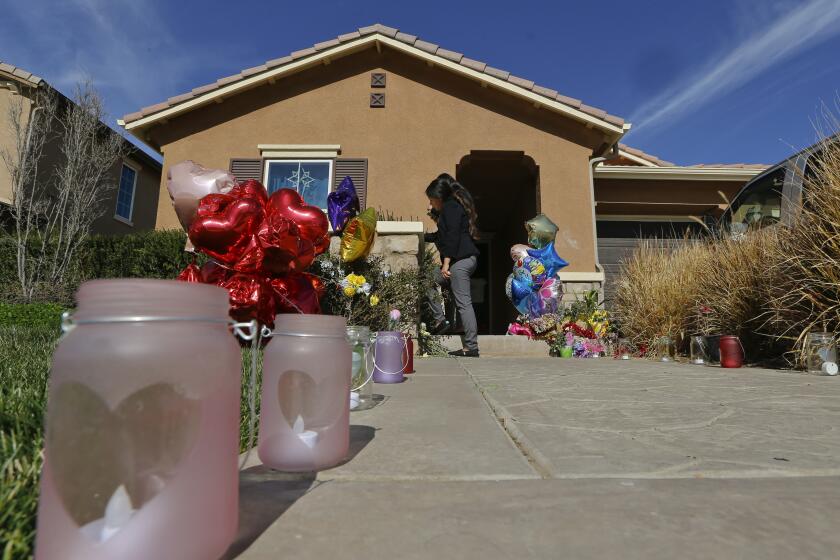Helping People Up Off Street : Shelters Wage a Quiet Battle for Those Who Have Lost Their Footing
It finally sank in last April, when the north Tustin family spent a fitful night behind a motel in two parked cars, making stealth trips to the service station bathroom, trying to convince the children not to be afraid.
David and Lucinda had both held solid jobs. Their kids once went to private school. They even had a maid. Now, the couple and their three children are among an estimated 12,000 to 15,000 homeless in Orange County, brought low by medical problems, chronic unemployment, and a web of Byzantine family feuds that left them with nowhere to turn.
“The kids were saying, ‘Mom, we can’t do this. What are we going to tell our friends at school?’ ” said Lucinda, who spends hours a day driving the children from the Costa Mesa shelter they call home to summer school and friends’ houses in the north Tustin area. “The kids don’t want anyone to know we’re here.”
They landed at the Orange Coast Interfaith Shelter’s emergency program, and after a week were enrolled in the shelter’s temporary program, where they share a cramped room with two sets of bunk beds and one single bed.
David learned Wednesday that he got a job with the county Department of Education, and the family will be moved into the shelter’s transitional program, a final phase designed to get them back on their feet for good. The family asked that their last name not be used to protect the children.
The high-profile conviction last Monday of Buena Park’s Rev. Wiley S. Drake for sheltering a group of homeless people in violation of city codes illuminates a chronic social ill many county residents would rather ignore; one that Lucinda and David say is greatly misunderstood.
Drake took his battle into the public arena. But many others, like the Orange Coast Interfaith Shelter, have been serving the county’s homeless quietly. Others are shuffling families from church to church, and crafting new programs to deal with those most vulnerable to homelessness, such as the HIV-infected and mentally ill.
While the Drake trial grabbed headlines, it barely registered for most front-line fighters against homelessness. They are concerned instead with a forecast for a wet winter. They are watching state funding wars that could close National Guard armories to the homeless here for the first time in years.
And they worry that welfare reform and food stamp cuts to legal immigrants are expected to fray an already thinning safety net.
“Remember the saying, ‘The economy will lift all ships?’ ” said Lee Podolak, president of Homeward Bound: The Orange County Homeless Coalition. “Well, it only lifts the yachts. I’m sorry to say, the rowboats are still down there.”
Some who work with the homeless daily say the improving economy means people like David are finding work, and getting on their feet faster. But the general situation remains grim: More than 12,000 people in the county have no place to live, and shelters have only about 1,000 beds.
“The homeless have gone underground,” said Kathi Winter, director of Global Outreach, an Irvine-based ministry for the homeless. “They’re spread out more, more disheveled, more alienated, more lonely. We don’t see them as much, but guess what? They’re not gone, and there are more women and children on the street every day.”
The bulk of those people are not pushing shopping carts or begging for change, said Jim Palmer, executive director of the Orange County Rescue Mission in Santa Ana.
“We know for a fact that we’re not talking about the people out there panhandling,” he said. “We’re talking about people on welfare who have three-week motel vouchers and no permanent address.”
*
The Rescue Mission, like Orange Coast Interfaith Shelter, focuses on long-term programs designed to make the homeless self-sufficient, Palmer said. His agency is among several poised to move in to the Tustin Marine Corps Helicopter Air Station, which is marked for closure by July 1999.
The new facility, to be called Tustin Recovery Village, will include 197 beds for men, women and children and include education, job placement and health care services, Palmer said.
“It’ll be a gigantic addition” to what’s currently available, he said.
In addition, more than $7 million in federal money awarded to local agencies last fall has yet to be doled out, due to what the county says are federal delays. Some of that money will go to create a 25-bed shelter for men and women with HIV, said Larry Haynes, executive director for Mercy House Transitional Living Center.
His agency has already applied for yet more federal money that would help the homeless at his shelters with transportation costs and follow-up care.
But that money does not cover emergency services, the nightly shelter that Drake would provide and that the county sorely lacks, said Jim Miller, president and CEO of the Westminster-based Shelter for the Homeless.
“We have a program where you can go from the street and end up in a home of your own, but we just don’t have enough emergency services for families,” Miller said.
About five years ago, his program had 10 single-family homes that served as emergency shelters. Now, because of funding cuts, he has two, Miller said.
Churches have stepped in to fill the need, Miller said, with the Shelter for the Homeless Interfaith Program, or SHIP. About 20 churches participate by housing homeless people at the church and feeding them for a week, before the program moves to another city and another congregation.
*
Miller said that about 70% of the homeless who come to the program are employed. And at Orange Coast Interfaith Shelter in Costa Mesa, executive director Gil Carmona said he is seeing homeless people from the middle class.
“We’re starting to see that wave come in--a new generation of homeless: educated, blue collar,” Carmona said. “Any setback like a disability or unemployment just throws them off. We see more and more people coming in never thinking they would use a homeless shelter.”
David, Lucinda and their three children are among them. A family dispute drove them from her father’s home. They moved in with David’s mother, but problems developed there too.
They found themselves at the Comfort Suites in Santa Ana, running out of savings. Their car was broken into, and all their teenage daughter’s clothes stolen from a box in the back. Now, after more than three months of shelter life, the couple’s two teenagers have yet to tell any of their friends about their double life.
“They wouldn’t believe me,” the teenage daughter said. “They wouldn’t like me.”
(BEGIN TEXT OF INFOBOX / INFOGRAPHIC)
Shelter Gap
County officials say there is a huge gap between bed and shelter need for the homeless and what is available through county-funded services:
Individuals
*--*
Inventory Unmet Need Emergency shelter 327 9,673 Transitional housing 1,382 6,618 Permanent housing 400 9,600
*--*
Families with Children
*--*
Inventory Unmet Need Emergency shelter 390 5,310 Transitional housing 791 6,781 Permanent housing 35 9,965
*--*
Note: Above does not include church or other independent shelter programs
Homeless Portrait
A major portion of Orange County’s homeless are children:
Total homeless: 12,000-15,000
Children under age 18: 7,000
Children with single parent: 5,700
*
Orange County:
Male 60%
Female 40%
*
White 65%
Black 25%
Latino 10%
(other) Less than 1%
Nationwide
Male 70%
Female 30%
*
White 61%
Black 17%
Latino 16%
Other: 6%
Sources: County of Orange Housing and Community Development, Orange County Rescue Mission; Researched by LEE ROMNEY / Los Angeles Times
More to Read
Sign up for Essential California
The most important California stories and recommendations in your inbox every morning.
You may occasionally receive promotional content from the Los Angeles Times.











